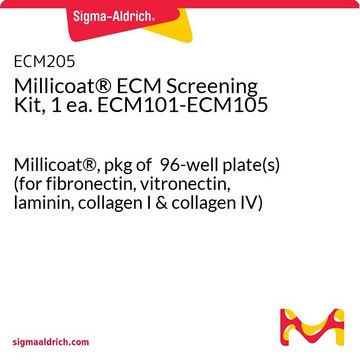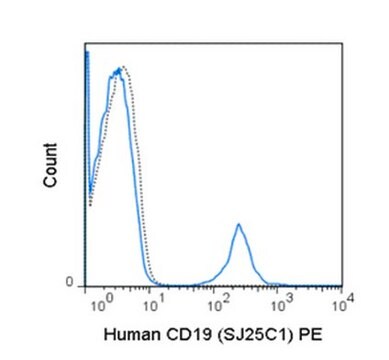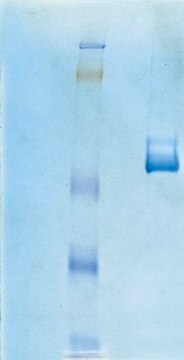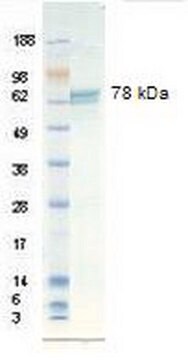ECM102
Human Vitronectin
MILLICOAT® Human Vitronectin Coated Strips (96-Wells), suitable for cell culture
Synonym(e):
Formerly under the CytoMatrix ™ brand name.
About This Item
Empfohlene Produkte
Produktbezeichnung
Millicoat® Human Vitronectin Coated Strips (96-Wells), Millicoat Cell Adhesion Strips are provided as 12 x 8-well removable strips in a 96-well plate frame for convenience & flexibility in designing assays.
Biologische Quelle
human
Qualitätsniveau
Form
lyophilized
Speziesreaktivität
human
Hersteller/Markenname
Chemicon®
Millicoat®
Methode(n)
activity assay: suitable
cell based assay: suitable
Aufnahme
sample type pancreatic stem cell(s)
sample type induced pluripotent stem cell(s)
sample type hematopoietic stem cell(s)
sample type: mouse embryonic stem cell(s)
sample type: human embryonic stem cell(s)
sample type neural stem cell(s)
sample type mesenchymal stem cell(s)
sample type epithelial cells
NCBI-Hinterlegungsnummer
UniProt-Hinterlegungsnummer
Nachweisverfahren
colorimetric
Versandbedingung
wet ice
Allgemeine Beschreibung
Anwendung
Zellstruktur
NOTE: Optimal assay timing and performance may vary for different cell lines but generally can be obtained using subconfluent cell cultures in the assay described below. Subconfluent cultures can be achieved by splitting cells 1 to 2 days prior to performing the assay.
1. Rehydrate the strips with 200 mL of PBS per well for at least 15 minutes at room temperature. Remove the PBS from the rehydrated strips.
2. Prepare a single cell suspension, preferably using a non-enzymatic dissociation buffer. Optimum cell density may be determined by titration of the cells. A common starting range is between 1x10E05 to 1x10E07 cells/mL.
3. Add 100 mL of the diluted cell suspension to each well. Incubate the plate at 37°C for 45 minutes in a CO2 incubator. Gently wash the plate 2-3 times with PBS containing Ca2+/Mg2+ (200 mL/well).
4. Add 100 mL of 0.2% crystal violet in 10% ethanol to each well. Incubate for 5 minutes at room temperature. Remove the stain from the wells. Gently wash the strips 3-5 times with PBS (300 mL/well) to remove the excess stain.
5. Add 100 mL of Solubilization Buffer (A 50/50 mixture of 0.1M NaH2PO4, pH 4.5 and 50% ethanol) to each well. Allow strips to incubate and gently shake at room temperature until the cell-bound stain is completely solubilized; approximately 5 minutes.
6. Determine the absorbance at 540 - 570 nm on a microplate reader.
Verpackung
Lagerung und Haltbarkeit
Rechtliche Hinweise
Haftungsausschluss
Lagerklassenschlüssel
11 - Combustible Solids
WGK
WGK 3
Flammpunkt (°F)
Not applicable
Flammpunkt (°C)
Not applicable
Analysenzertifikate (COA)
Suchen Sie nach Analysenzertifikate (COA), indem Sie die Lot-/Chargennummer des Produkts eingeben. Lot- und Chargennummern sind auf dem Produktetikett hinter den Wörtern ‘Lot’ oder ‘Batch’ (Lot oder Charge) zu finden.
Besitzen Sie dieses Produkt bereits?
In der Dokumentenbibliothek finden Sie die Dokumentation zu den Produkten, die Sie kürzlich erworben haben.
Artikel
Extracellular matrix proteins such as laminin, collagen, and fibronectin can be used as cell attachment substrates in cell culture.
Verwandter Inhalt
This page covers the ECM coating protocols developed for four types of ECMs on Millicell®-CM inserts, Collagen Type 1, Fibronectin, Laminin, and Matrigel.
Unser Team von Wissenschaftlern verfügt über Erfahrung in allen Forschungsbereichen einschließlich Life Science, Materialwissenschaften, chemischer Synthese, Chromatographie, Analytik und vielen mehr..
Setzen Sie sich mit dem technischen Dienst in Verbindung.







